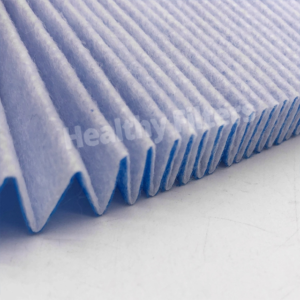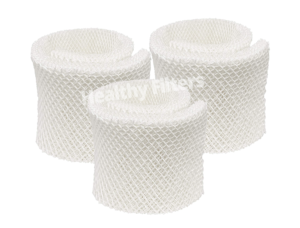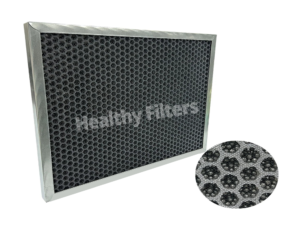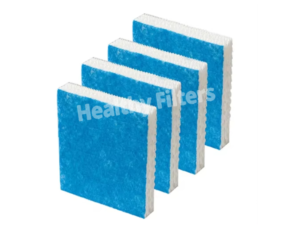Synthetic Fiber Pocket Filter F8 is a high-efficiency air filtration device that complies with EN 779:2012 F8 level (corresponding to ISO 16890 ePM1 80%-90% and MERV 15-16), and is designed to intercept 0.2-5μm ultrafine particles (such as virus carriers, bacteria, smoke, industrial smoke and aerosols). It adopts multi-layer composite electret fiber and reinforced bag structure to achieve filtration performance close to HEPA (H12 level) at low energy consumption. It is an ideal choice for highly sensitive environments such as pharmaceutical sterile workshops, electronic clean rooms, and biological laboratories, providing dual protection for process cleanliness and personnel health.
Core structure and technical parameters
Material and process
Filter material:
Ultrafine electret fiber: glass fiber and polyester fiber composite (Hybrid), fiber diameter ≤1μm, gradient density design (coarse efficiency + medium efficiency + high efficiency layer), combined with electrostatic electret technology to enhance the adsorption capacity of 0.2μm particles;
Functional coating: optional antibacterial (silver ion), hydrophobic or flame retardant treatment, suitable for harsh working conditions.
Bag structure: 16-32 V-shaped or W-shaped pleated filter bags, effective filtration area is 6-10 times that of flat filter materials, dust holding capacity is 1000-1500g/m², significantly extending the replacement cycle.
Sealing frame: reinforced galvanized steel or flame retardant polypropylene (PP) frame, temperature resistant -40℃ to 100℃, silicone or EPDM sealing strips are used on the edges to ensure zero leakage.
Performance parameters
Filtration efficiency:
PM0.3 filtration efficiency ≥90% (corresponding to ISO ePM1 90%+), PM0.5 ≥95% (0.5μm particle interception rate ≥98%);
Complies with EN 779 F8 standard (average efficiency for 0.4μm particles ≥90%-95%).
Initial pressure difference: ≤110Pa (@rated air volume), energy consumption is 10%-20% lower than that of traditional F8 filter element.
Environmental tolerance: humidity ≤95% RH (moisture-proof model optional), resistant to weak acids and weak alkalis (pH 4-10).
Core advantages
Advantage dimensions Specific performance User value
Ultra-efficient purification The interception capacity of viruses and submicron particles is close to HEPA H12 level. It meets ISO Class 6 clean room or operating room air standards
Long-term economy Ultra-high dust holding capacity design, replacement cycle up to 18-24 months Operation and maintenance costs are reduced by 40%, reducing the frequency of downtime maintenance
Safety and compliance Comply with medical-grade biosafety (ISO 14644-1), no ozone release Adapt to GMP/ISO Class 5 clean workshops and biosafety laboratories
Flexible adaptation Support non-standard customization (thickness 150-600mm, number of filter bags 16-48 bags) Adaptive air volume 5,000-30,000m³/h System requirements
Typical application scenarios
Biopharmaceuticals:
Monoclonal antibody production line, vaccine filling workshop, interception of virus and bacterial aerosols;
Sterile API production environment to ensure that the drug is free of particulate contamination.
Electronic semiconductors:
Wafer manufacturing workshop, photolithography machine environmental control, intercepting particles larger than 0.2μm, improving yield rate;
Microelectronic packaging line, preventing metal dust from causing circuit short circuit.
Medical health:
Bone marrow transplant ward, negative pressure isolation ward, blocking the spread of pathogens;
Gene sequencing laboratory, protecting precision instruments from contamination.
Food and precision industry:
Aseptic packaging line, microelectronic component assembly workshop, maintaining ultra-clean environment;
Nuclear power plant control room ventilation system, blocking the spread of radioactive particles.
Selection and maintenance guide
Accurate selection suggestions
Air volume matching:
Select the number and depth of filter bags according to the system air volume (such as 20,000m³/h corresponds to 24-32 bags, depth ≥400mm);
The wind speed is recommended to be ≤1.8m/s to avoid efficiency attenuation and pressure difference surge.
Adaptation of pollution characteristics:
High biological risk (such as P3 laboratory): select antibacterial + hydrophobic composite filter material;
Corrosive gas (such as chemical workshop): select acid and alkali resistant frame and coating.
Intelligent maintenance strategy
Pressure difference monitoring: Install intelligent pressure difference sensor, the recommended replacement threshold is initial pressure difference × 2.5 (usually ≤ 275Pa);
Cleaning method:
Surface dust can be gently cleaned with a vacuum cleaner (wet wiping or high-pressure backblowing is prohibited to avoid failure of the electret layer);
Directly replace when seriously blocked, cleaning and reuse are not supported.
Replacement cycle:
Conventional scenario (pharmaceutical workshop): 12-18 months;
High pollution scenario (welding, chemical industry): 6-12 months.
Technological innovation and industry trends
Intelligent IoT integration: built-in RFID chip and Bluetooth module, real-time upload of operating data to the building management system (BMS) to achieve predictive maintenance;
Nano-composite technology: graphene coating improves conductivity and filtration efficiency, and simultaneously degrades VOCs;
Green cycle design: using 30% recycled fiber materials (GRS certified), reducing carbon footprint by 25%, supporting carbon neutrality goals.
Synthetic fiber bag filter F8 takes **”extreme cleanliness, ultra-long life, and intelligent interconnection”** as its core value, becoming a benchmark product for ultra-clean environment air treatment. From biopharmaceuticals to cutting-edge electronics, it not only defines a new height of air quality, but also drives the industry towards an efficient and low-carbon future with innovation.





